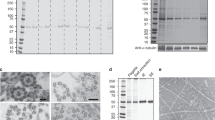Summary
Macronuclear DNA of the hypotrichous ciliate Stylonychia lemnae contains two size-classes of molecules coding for α-tubulin. Analysis of their coding regions demonstrates that these two size-classes represent two different functional α-tubulin genes, α1 and α2; a comparison of these regions shows a 97% homology in their nucleotide sequence and 98.5% in their amino acid sequence. S1-mapping experiments indicate that both α1-and α2-tubulin genes are transcribed. The 5′ and 3′ noncoding regions flanking the α1- and α2-tubulin genes differ in both length and nucleotide sequence within one strain. When different strains are compared, however, identical non-coding regions and slightly varying coding regions can be found in DNA molecules containing the α1-tubulin genes.
Similar content being viewed by others
References
Ammermann D (1965) Arch Protistenk 108:109–152
Ammermann D (1971) Chromosoma 33:209–238
Ammermann D, Steinbrück G, Berger L v, Hennig W (1974) Chromosoma 45:401–429
Baker CC, Herisse J, Coutois G, Galibert E, Ziff E (1979) Cell 18:569–580
Birnstiel ML, Busslinger M, Strub K (1985) Cell 41:349–359
Bucher P, Trifonov E (1986) Nucleic Acid Res 14:10009–10026
Caron F, Meyer E (1985) Nature 314:185–188
Cleveland DW, Sullivan KF (1985) Annu Rev Biochem 54:331–365
Cowan NJ (1984) In: Maclean N (ed) Oxford surveys on eukaryotic genes, vol 1. Oxford University Press, Oxford London, pp 36–60
Elsevier SM, Lipps HJ, Steinbrück G (1978) Chromosoma 69:291–306
Ginzburg J, Behar L, Divol D, Littauer UZ (1981) Nucleic Acid Res 9:2691–2697
Glisin V, Crkvanjakow R, Byus C (1974) Biochemistry 13:2633–2637
Grass DS, Jove R, Manley JL (1987) Nucleic Acid Res 15:4417–4436
Grunstein M, Hogness D (1975) Proc Natl Acad Sci USA 72:3961–3965
Helftenbein E (1985) Nucleic Acid Res 13:415–433
Horowtiz S, Gorovsky MA (1985) Proc Natl Acad Sci USA 82:2452–2455
Kaine BP, Spear BB (1982) Nature 295:430–432
Klobutcher LA, Swanton MT, Donini P, Prescott DM (1981) Proc Natl Acad Sci USA 78:3015–3019
Konkel DA, Tilghman S, Leder P (1978) Cell 15:1125–1132
Korn LJ, Brown DD (1978) Cell 15:1145–1156
Lawn RM, Herrick G, Heumann J, Prescott DM (1978) Cold Spring Harbor Symp Quant Biol 42:483–492
Lemischka I, Sharp PA (1982) Nature 300:330–335
Lipps HJ, Steinbrück G (1978) Chromosoma 69:21–26
Mandelkow EM, Herrmann K, Rühl U (1985) 185:311–327
Maniatis T, Fritsch EF, Sambrock J (1982) Molecular cloning, a laboratory manual. Cold Spring Harbor Laboratory Press, Cold Spring Harbor, NY
Maxam AM, Gilbert W (1977) Proc Natl Acad Sci USA 74:560–564
Meyer GF, Lipps HJ (1980) Chromosoma 77:285–297
Meyer GF, Lipps HJ (1982) Chromosoma 82:309–314
Miller KG, Sollner-Webb B (1981) Cell 27:165–174
Miller DL, Krupp JL, Shu HH, Martin NC (1985) Nucleic Acid Res 13:859–872
Monteiro MJ, Cox RA (1987) J Mol Biol 193:427–438
Nock A (1981) Chromosoma 83:209–220
Ponstingl H, Little M, Krauhs E (1984). In: Hearn MTW (ed) Peptide and protein reviews, vol 2. Dekker, New York, pp 1–81
Preer JR, Preer LB, Rudman BM, Barnett AJ (1985) Nature 314:188–191
Proudfoot NJ, Brownlee GG (1976) Nature (Lond) 263:211–214
Sanger F, Nicklen S, Coulson AR (1977) Proc Natl Acad Sci USA 74:5463–5467
Serrano L, Avila J, Maccioni RB (1984a) Biochemistry 23:4675–4681
Serrano L, de la Torre J, Maccioni RB, Availa J (1984b) Proc Natl Acad Sci USA 81:5989–5993
Steinbrück G, Haas I, Hellmer KH, Ammermann D (1981) Chromosoma 83:199–208
Valenzuela P, Quiroga M, Zaldivar J, Rutter WJ, Kirschner MW, Cleveland DW (1981) Nature 289:650–655
Weaver RF, Weissmann C (1979) Nucleic Acid Res 7:1175–1193
Wünning IU, Lipps HJ (1983) EMBO J 2:1753–1757
Yanisch-Perron C, Vieira J, Messing J (1985) Gene 33:103–119
Author information
Authors and Affiliations
Rights and permissions
About this article
Cite this article
Helftenbein, E., Müller, E. Both α-tubulin genes are transcriptionally active in Stylonchyia lemnae . Curr Genet 13, 425–432 (1988). https://doi.org/10.1007/BF00365664
Received:
Issue Date:
DOI: https://doi.org/10.1007/BF00365664




